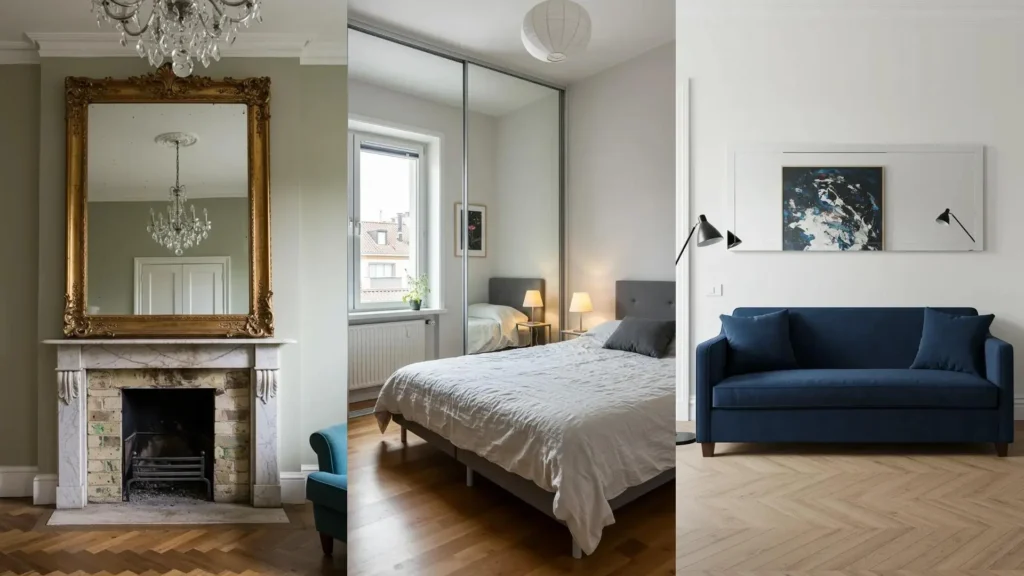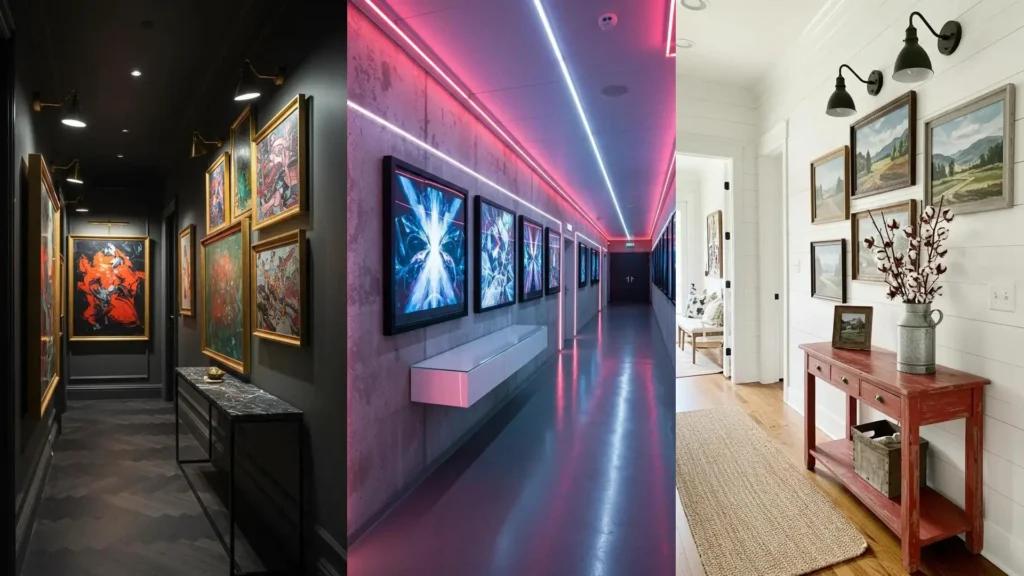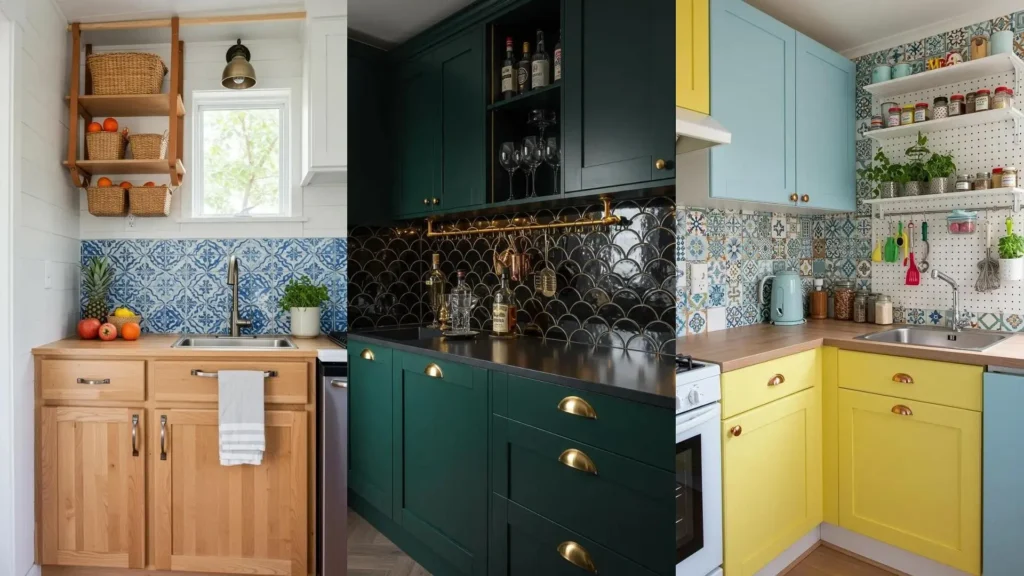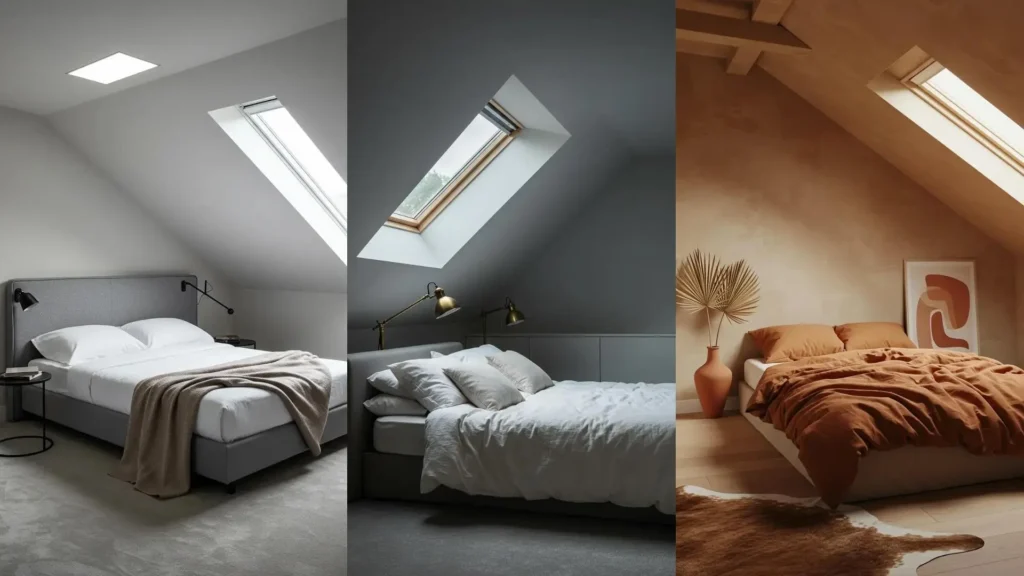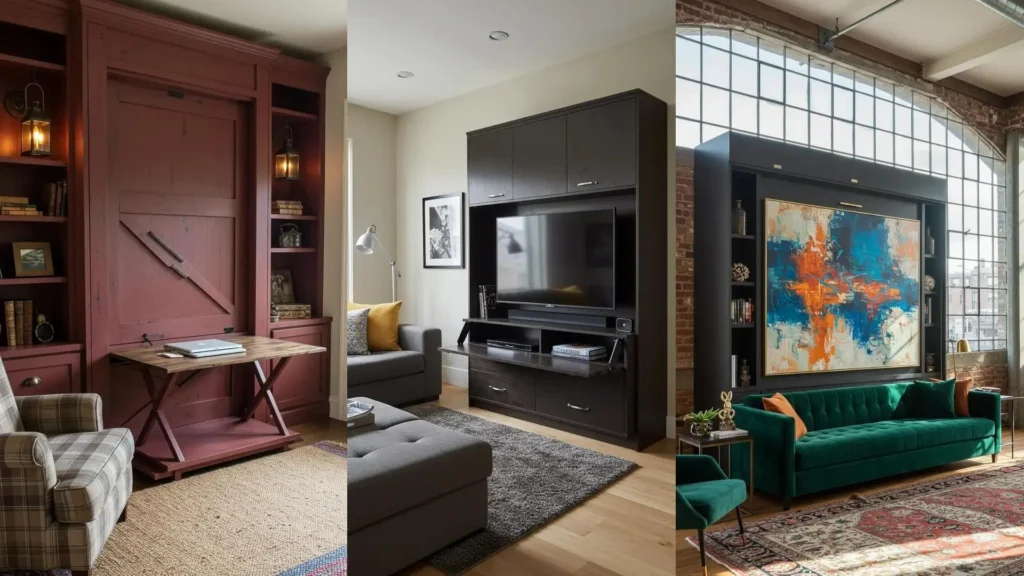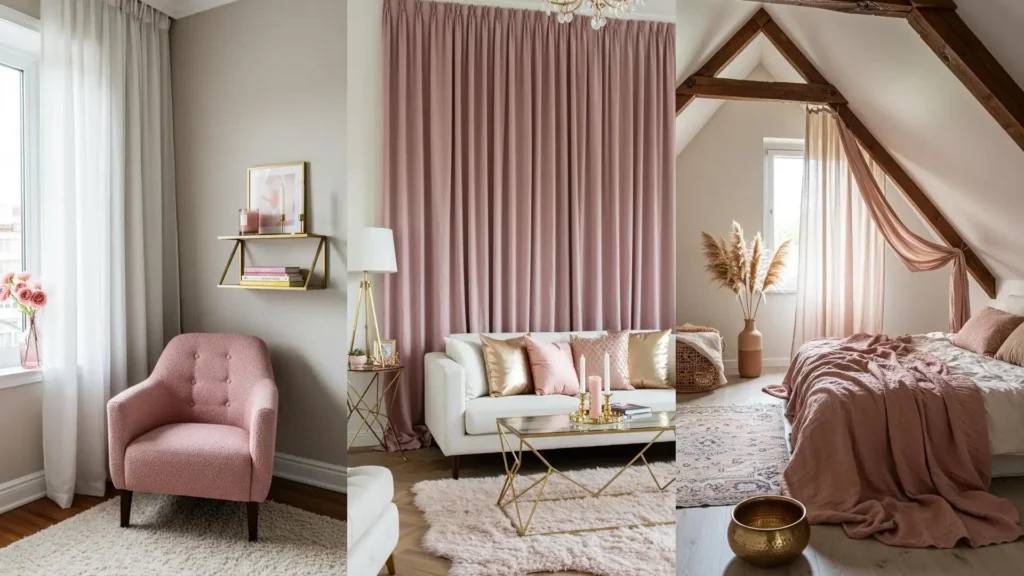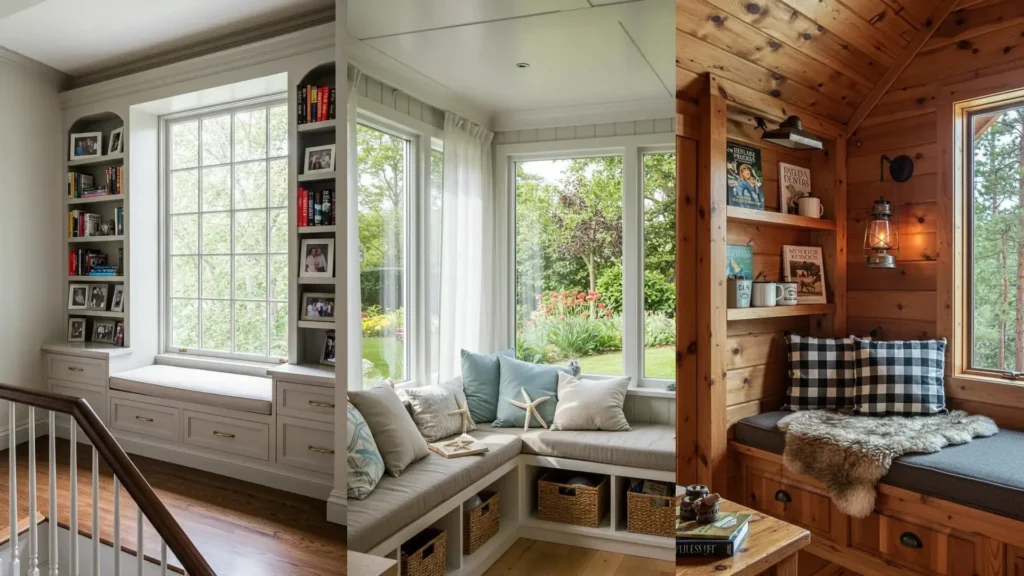When you live in a small space, every design choice becomes an opportunity. A mirror, perhaps more than any other object, holds the power to completely reshape your perception of a room.
It is not merely a decorative piece, but a strategic tool for manipulating light and perspective. It can carve out depth where none exists, amplify a sliver of sunlight into a brilliant wash, and erase visual boundaries to make a room feel limitless.
Here, we will explore not just where to place a mirror, but why each placement works—so you can transform your home with intention, creating spaces that feel more expansive, brighter, and infinitely more beautiful.
1. Create an Illusionary Doorway
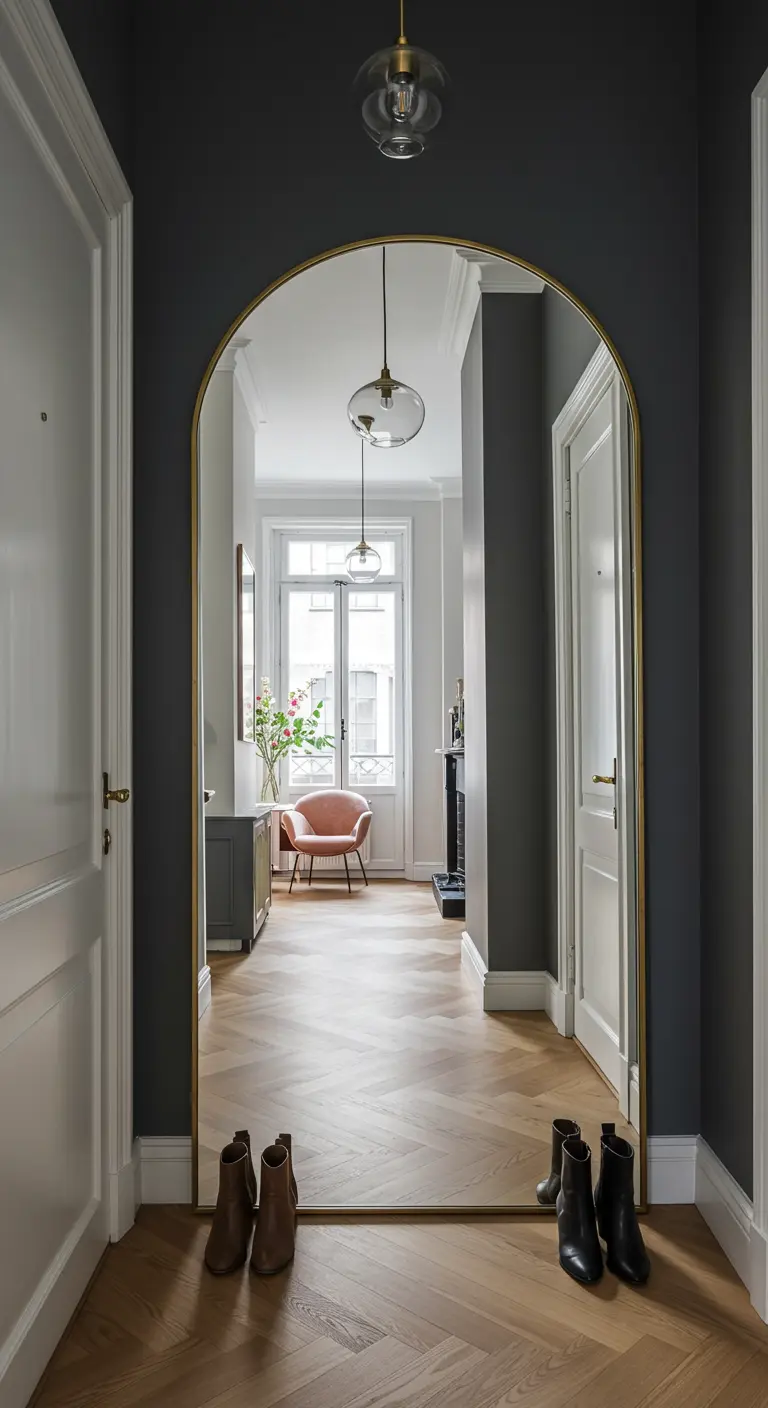
In a narrow hallway, a floor-length arched mirror does more than just reflect; it creates the illusion of another room just beyond.
Place it at the end of a corridor to draw the eye forward, making the entire passage feel longer and more intentional.
The contrast between a dark, moody wall color and the bright reflection adds drama and depth, while a slim metallic frame lends a touch of warmth.
This is one of the most effective ways to decorate a tiny entryway or passage, turning a functional path into a beautiful destination.
2. Layer Art Over a Landscape Mirror

A large horizontal mirror hung behind a sofa will instantly make the wall feel wider and the room more expansive.
To prevent it from feeling sterile, treat the mirror as a backdrop.
Layering a smaller, beloved piece of art directly onto the mirror’s surface adds personality and creates a dynamic focal point, proving you don’t have to choose between reflection and decoration.
This technique feels curated and intentional, perfect for elegant monochrome living rooms where texture and layers are key.
3. Double Your Natural Light
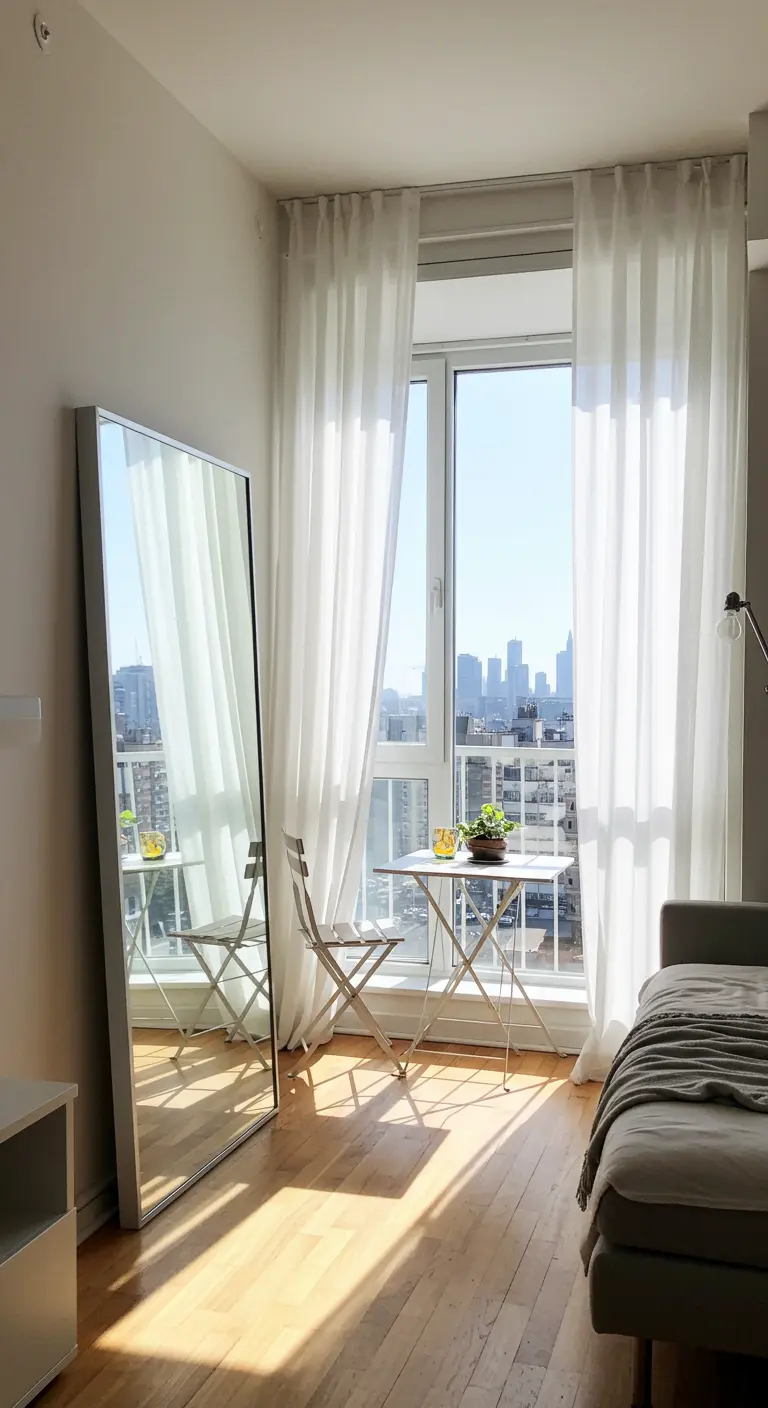
The single most powerful placement for a mirror is opposite or adjacent to a window.
By positioning a large, full-length mirror to capture the view and sunlight, you effectively create a second window in the room.
The space is immediately flooded with light, making it feel significantly brighter and more open.
Leaning it against the wall, as seen here, offers a relaxed, contemporary feel suitable for elevated studio apartment designs.
4. Compose a Reflective Gallery Wall
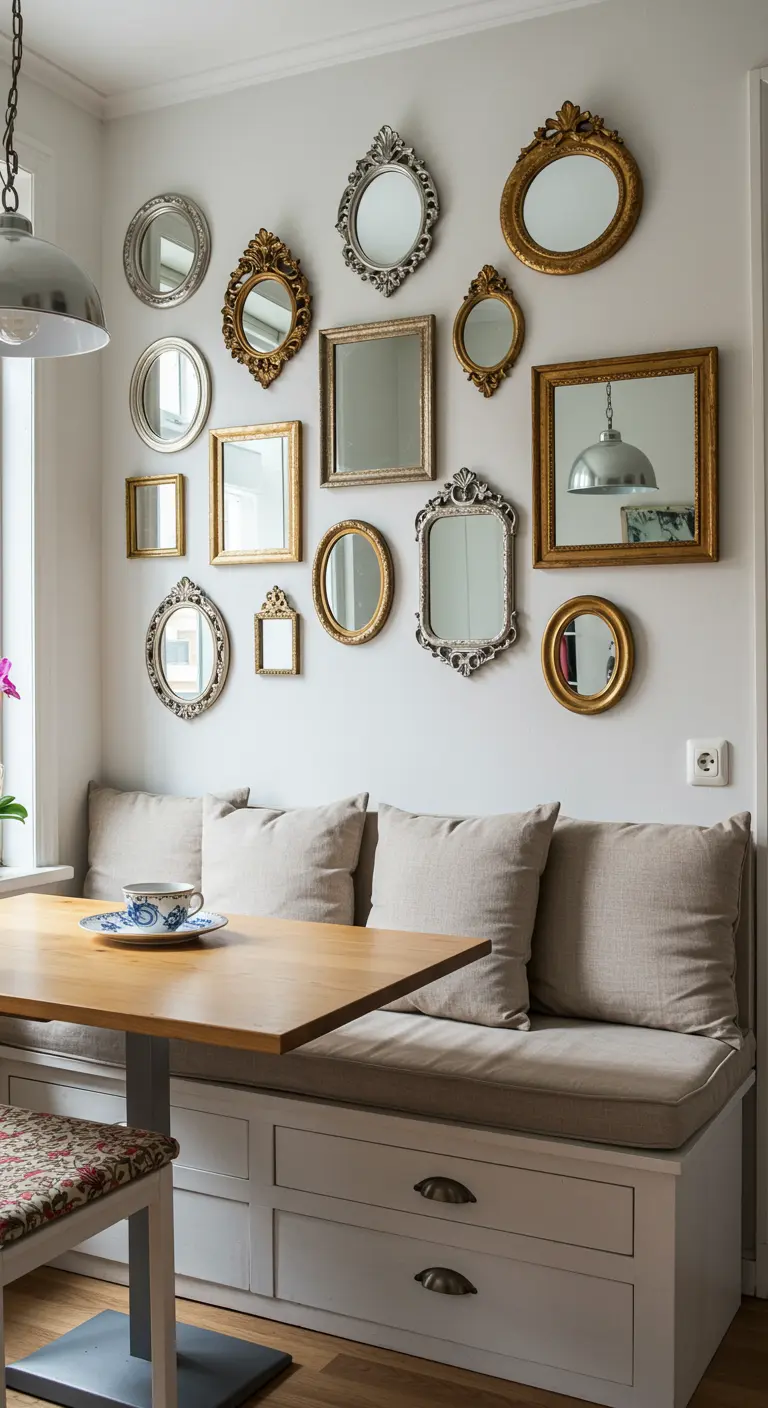
Instead of one large mirror, consider curating a collection of smaller ones to create a sparkling gallery wall.
Mix different shapes, sizes, and frame finishes—from ornate gold to simple silver—for a look that feels personal and gathered over time.
This approach breaks up a large wall and scatters light in interesting, fractured ways, adding character and brightness above a sofa or dining banquette.
It’s one of my favorite gallery wall layouts for adding depth to a compact living area.
5. Install a Mirrored Backsplash

In a galley kitchen or any compact cooking space, a mirrored backsplash is a transformative design choice.
It instantly doubles the visual width of your countertops and bounces light around, completely eliminating the feeling of being closed in.
For a more practical and subtle option, consider a smoked or antiqued mirror finish, which is more forgiving with splashes and adds a layer of sophisticated warmth.
This is a brilliant strategy for even the most stylish eat-in kitchen layouts where space is at a premium.
6. Erase a Wall with Mirror Panels
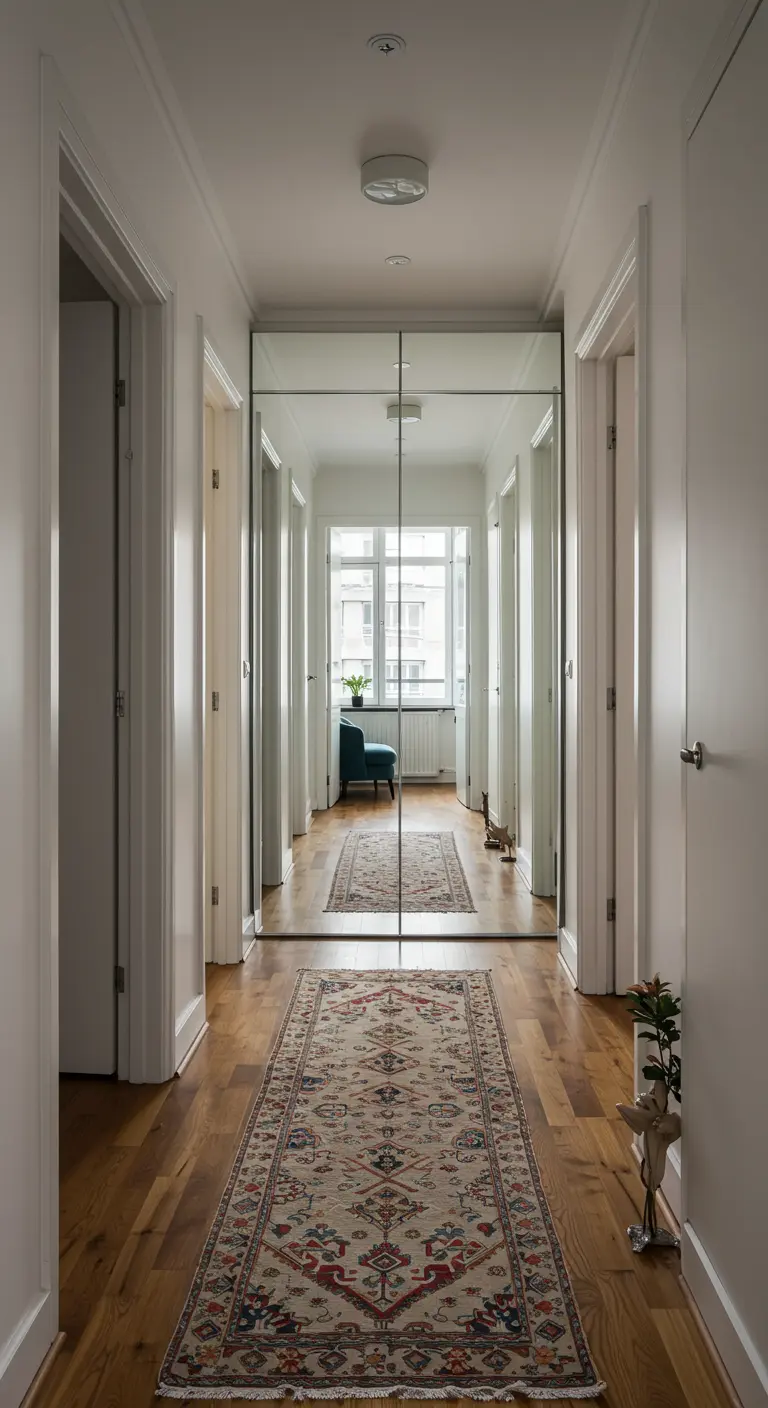
For the most dramatic effect, cover an entire wall with floor-to-ceiling mirror panels.
This works especially well at the end of a long, narrow corridor, as it completely dissolves the physical boundary of the room.
The reflection creates a seamless, powerful illusion of a much longer space ahead, making the architecture feel boundless.
A frameless application enhances the magic, making it a key feature in contemporary zen homes.
7. Swap Solid Closet Doors for Mirrored Ones
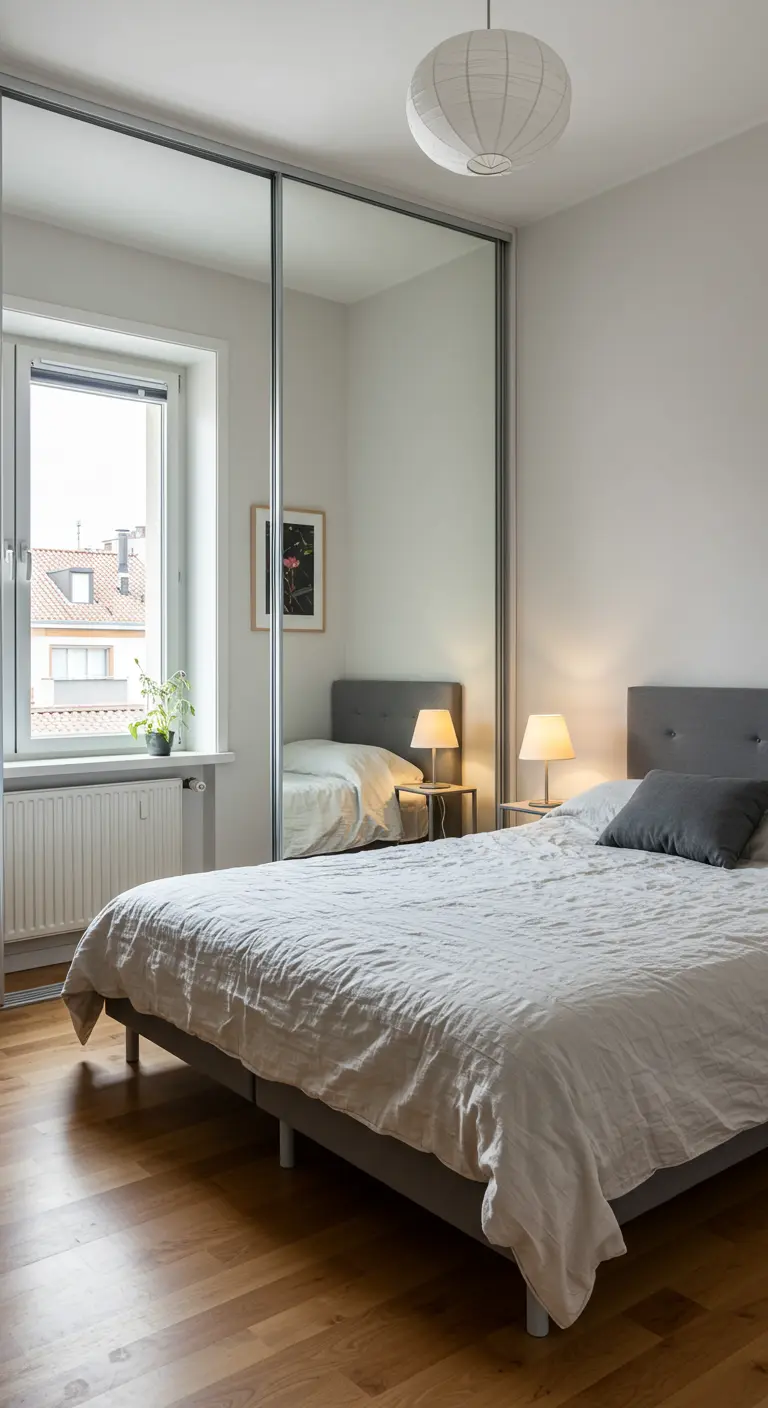
Mirrored closet doors are a classic, hardworking solution for small bedrooms.
They serve a dual purpose: providing essential full-length reflection without taking up precious wall space, and making the room feel significantly larger by reflecting the interior back on itself.
For an updated look, choose sleek, frameless sliding doors that blend seamlessly with the wall, enhancing the illusion of space.
This element is invaluable in romantic minimalist loft bedrooms.
8. Add Atmosphere with Backlighting

Elevate a simple floor mirror from a functional object to a design feature by adding backlighting.
Affixing LED light strips to the back of the frame creates a soft, ambient glow that emanates from the edges.
This not only adds a beautiful, moody light source to a dark corner but also gives the mirror a floating, ethereal quality that adds depth and sophistication.
9. Punctuate a Bookshelf with a Round Mirror

A large, densely packed bookshelf can feel visually heavy.
Break up the grid of books by placing a round mirror in one of the central compartments.
The soft, circular shape provides a welcome contrast to the hard lines of the shelves and spines, while its reflection adds a surprising element of depth and light, making the entire unit feel more dynamic.
10. Anchor an Entryway with a Circular Mirror
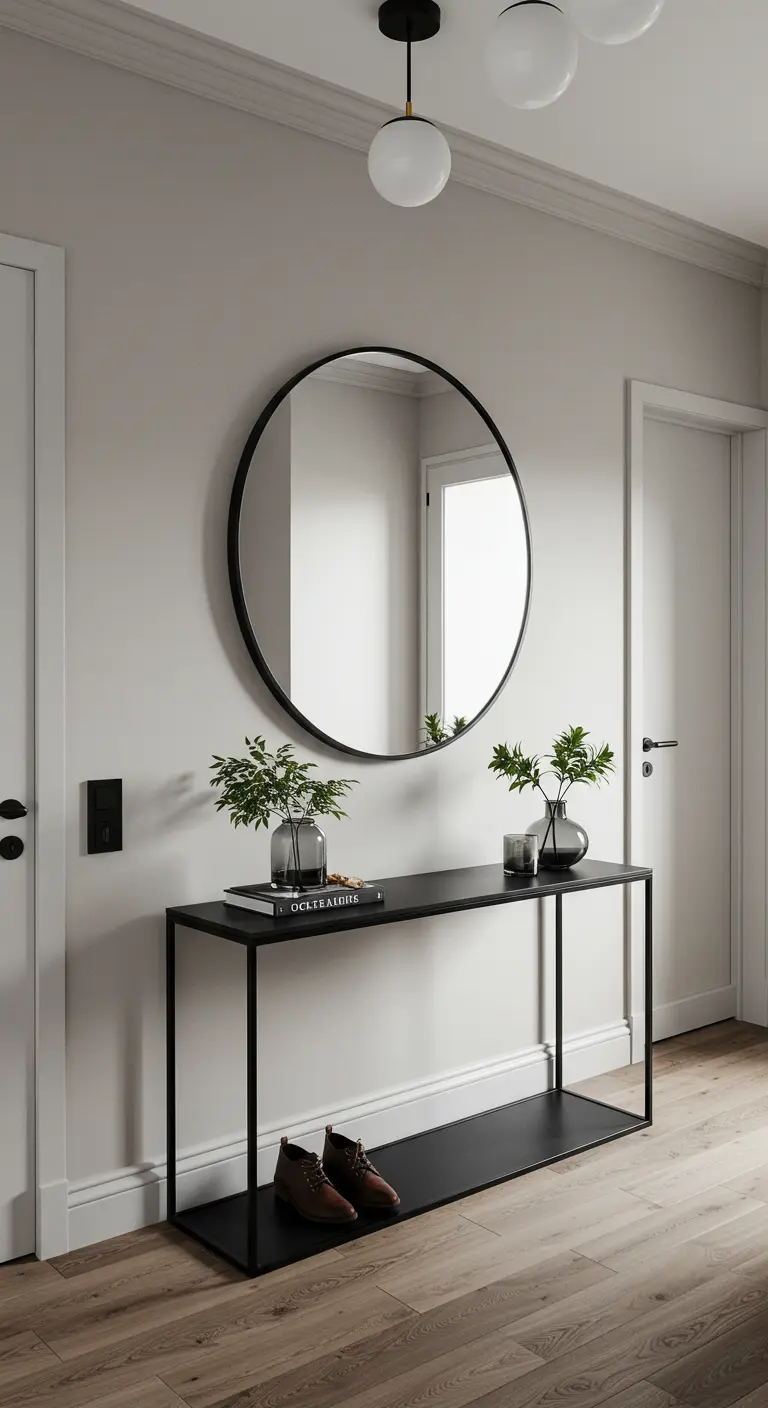
A large round mirror is a perfect anchor for an entryway console table.
Its curved shape feels inherently welcoming and less rigid than a rectangle, setting a soft, inviting tone for your home.
Positioned above a slim table, it creates a practical and beautiful vignette that makes the entry feel wider and brighter, offering a final check before you leave.
11. Opt for Mirrored Accent Furniture

When every square inch matters, choose furniture that feels visually weightless.
A mirrored side table, like this hexagonal piece, reflects the flooring, rug, and nearby furniture, effectively making it disappear.
This allows you to add a functional surface for a lamp or a cup of tea without contributing to visual clutter, keeping the room feeling airy and uncluttered.
It’s a glamorous touch that works well in luxe, glam spaces.
12. Dissolve a Corner with Mirrored Tiles
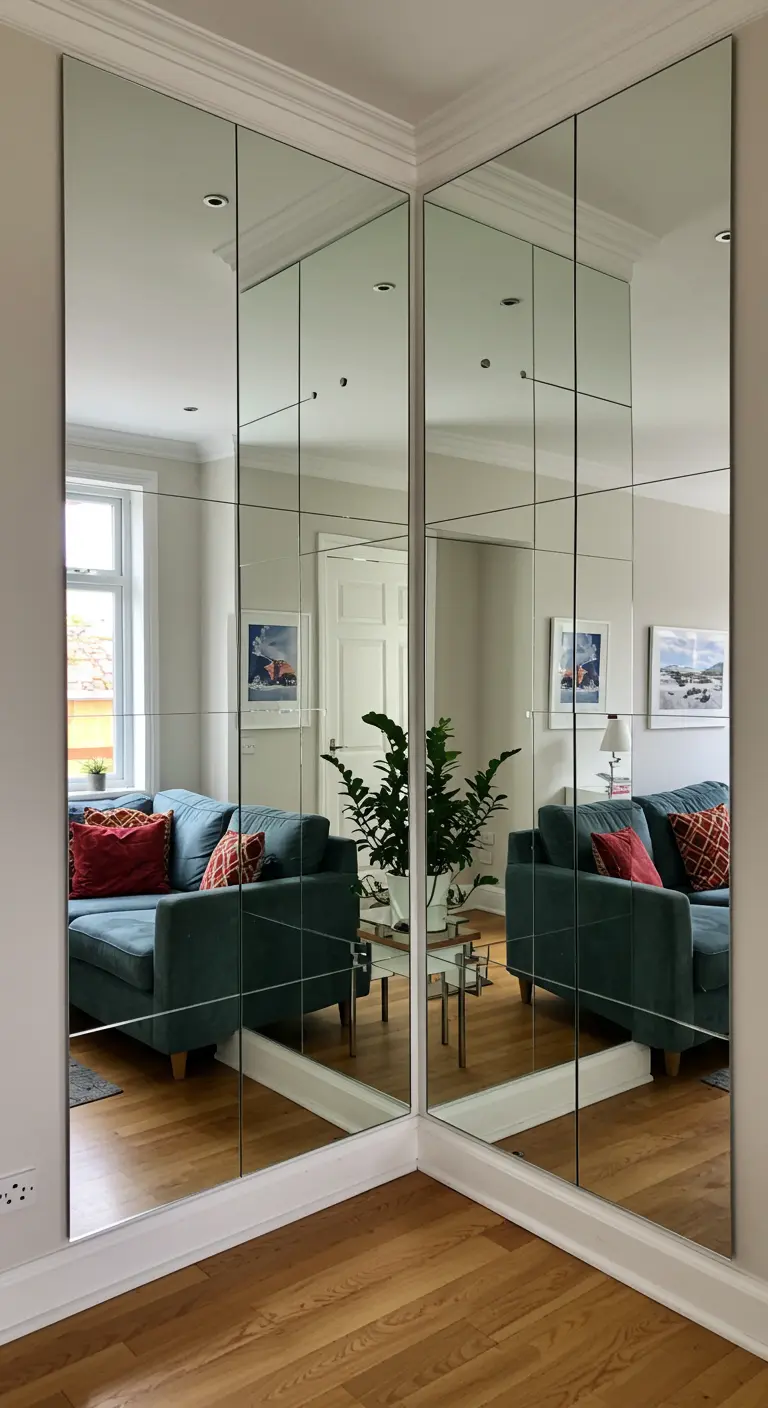
Corners physically define the limits of a room, but mirrored panels can make those limits disappear.
By cladding a corner in floor-to-ceiling mirrored tiles, you create a complex reflection that confuses the eye and dissolves the hard angle.
This architectural trick makes the room’s boundaries feel ambiguous and therefore more expansive, creating a fascinating and light-filled feature.
13. Create Height with a Mirror Triptych

To make a low ceiling feel higher, use verticality to your advantage.
Hanging three identical tall, narrow mirrors in a series creates a strong rhythmic line that draws the eye upward.
This grouping feels more architectural and intentional than a single mirror, adding a sense of structure and elegance to an otherwise blank wall while visually stretching the room.
14. Amplify Your Ambient Lighting

A mirror’s light-enhancing power isn’t limited to daytime.
Thoughtfully position a floor or wall mirror to capture and reflect the glow from an artificial light source, like a floor lamp or pendant light.
This simple placement will double the impact of your lighting, washing the room in a warmer, brighter glow and creating beautiful, layered light in the evening.
15. Recess a Mirror for Architectural Depth
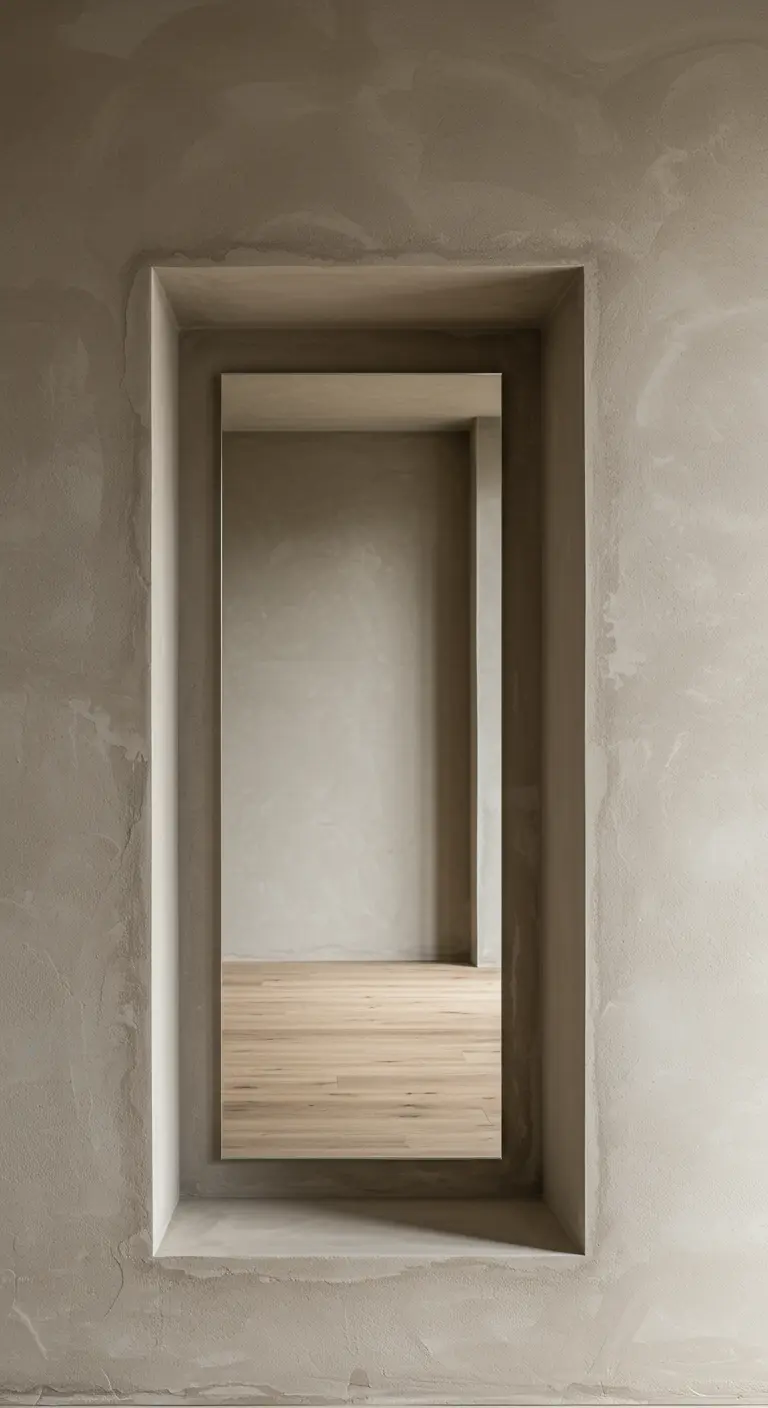
If your home has a structural niche or alcove, use it to create an extraordinary illusion of depth.
Fit a custom, frameless mirror perfectly within the recess.
This masterful trick makes the reflection appear not as a reflection at all, but as an opening to an entirely separate room, adding intrigue and a profound sense of space.
It’s a technique that feels right at home in wabi-sabi style spaces.
16. Establish a Grand Focal Point
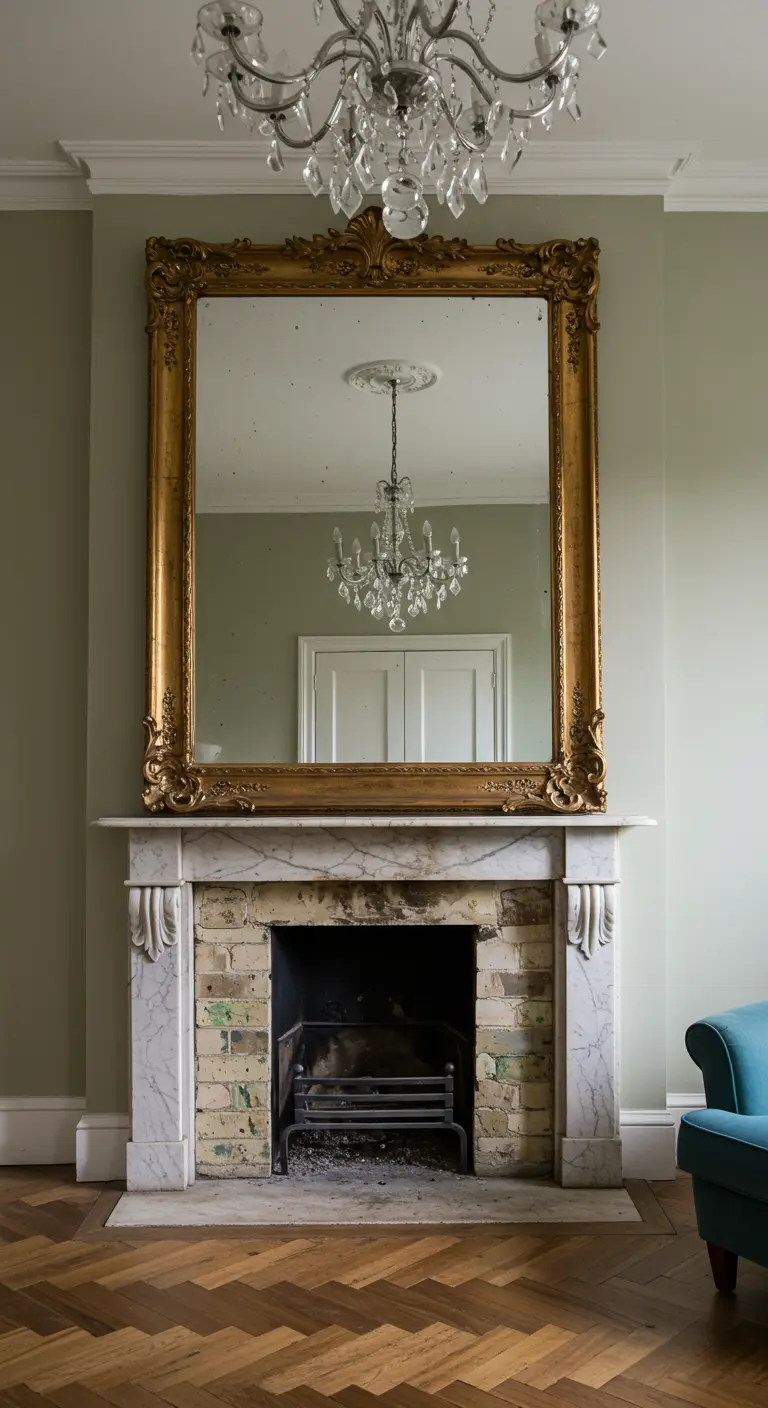
In a traditional room with classic bones, lean into the grandeur.
A large, ornate mirror with a gilded frame placed above a fireplace mantel instantly elevates the space.
It acts as a formal focal point, balances the visual weight of the hearth, and reflects the sparkle from a chandelier, making the entire room feel taller and more stately.
17. Divide a Space with a Tinted Mirror
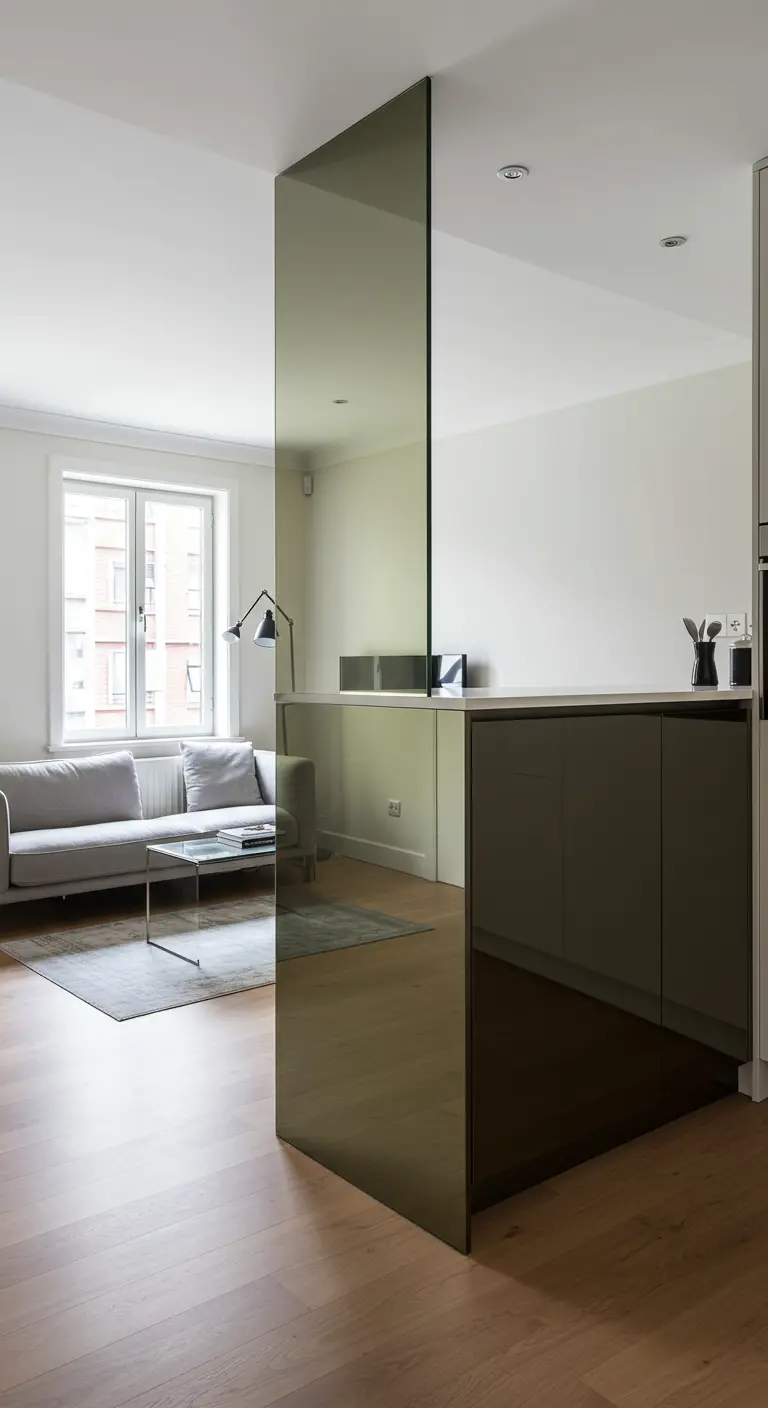
To define zones in an open-plan layout without building a wall, use a tinted mirror panel.
A bronze or smoke-tinted mirror can subtly separate a living area from a kitchen while still allowing light to pass through.
The darker, warmer reflection is less distracting than a standard mirror and adds a chic, sophisticated quality.
It’s a more permanent solution than curtain room dividers but achieves a similar goal.
18. Liberate a Small Workspace

A desk tucked into an alcove or corner can often feel confining.
Counteract this by backing the entire niche with a large, custom-cut mirror before installing your desk and shelving.
The mirror reflects the room behind you, preventing you from feeling like you’re facing a wall and making the workspace feel bright, open, and fully integrated with the rest of the space.
19. Go Wall-to-Wall in the Bathroom
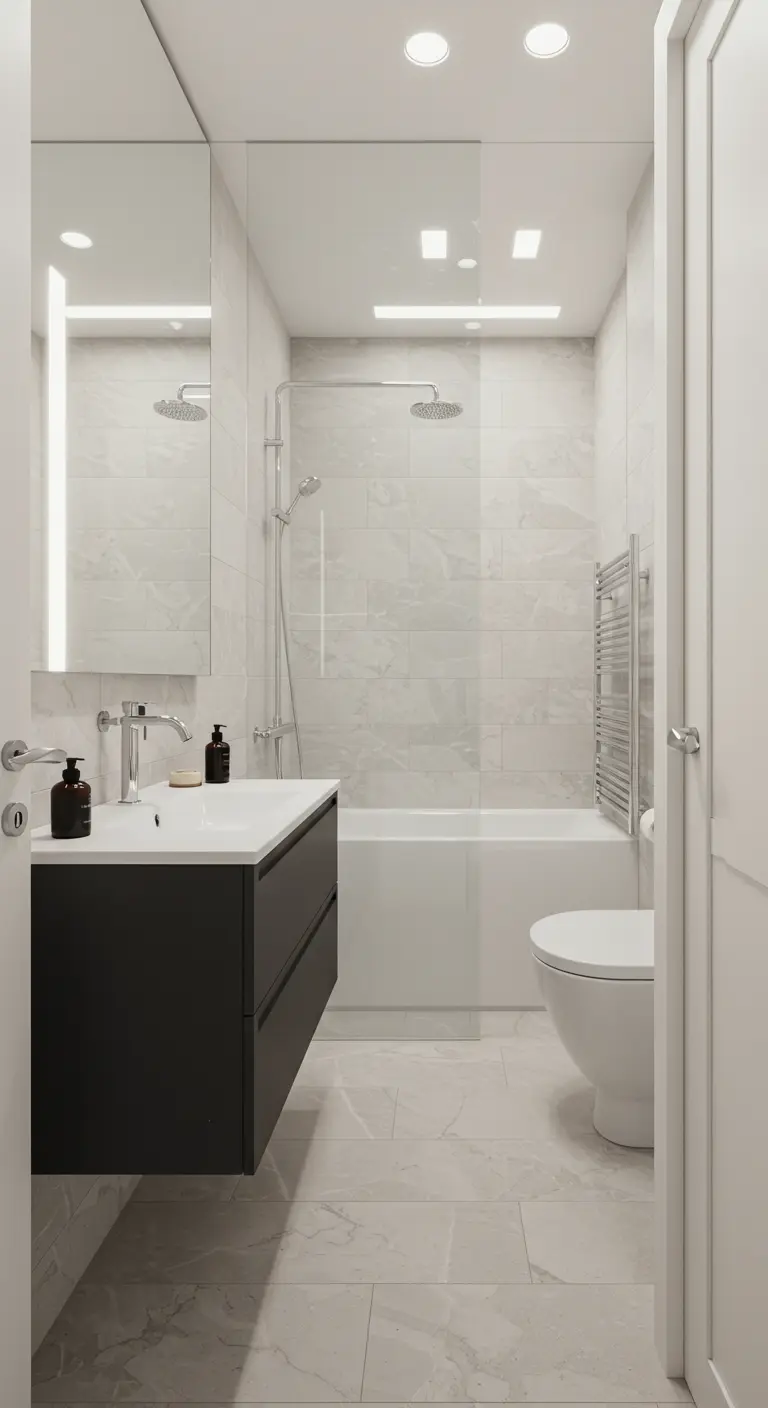
In a small bathroom, forgo a modest vanity mirror in favor of a much larger statement.
Install a simple, frameless mirror that extends from the top of the vanity all the way to the ceiling, and from wall to wall if possible.
This single change will make the room feel exponentially larger, cleaner, and brighter, creating the feeling of a luxurious spa-like bathroom retreat.
20. Add Height Beside a Desk
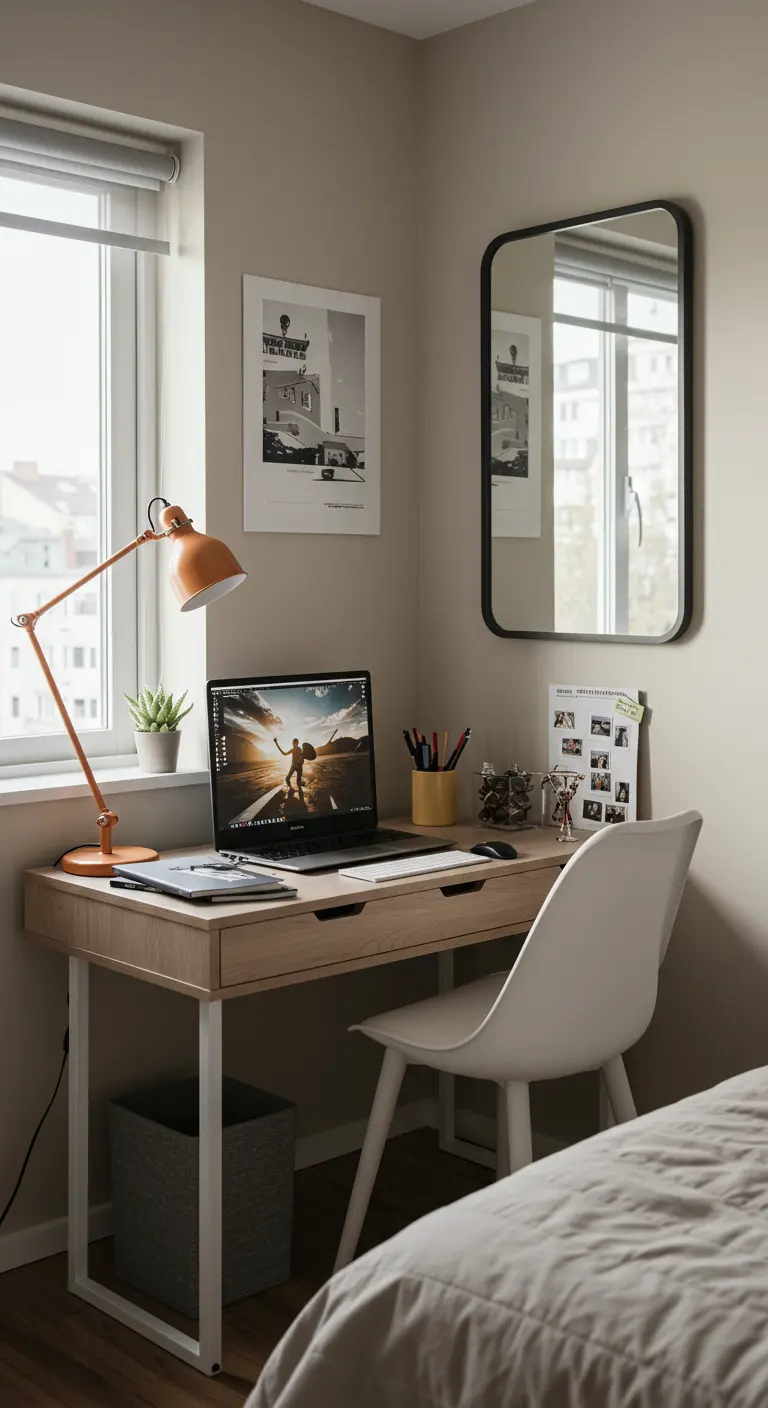
When a bedroom corner must also function as a workspace, every design choice matters.
A vertically oriented mirror with soft, rounded corners hung beside the desk draws the eye upward, giving the corner a sense of height.
It also reflects light from the window without creating a distracting reflection of your computer screen or work clutter.
21. Introduce Texture with a Woven Frame
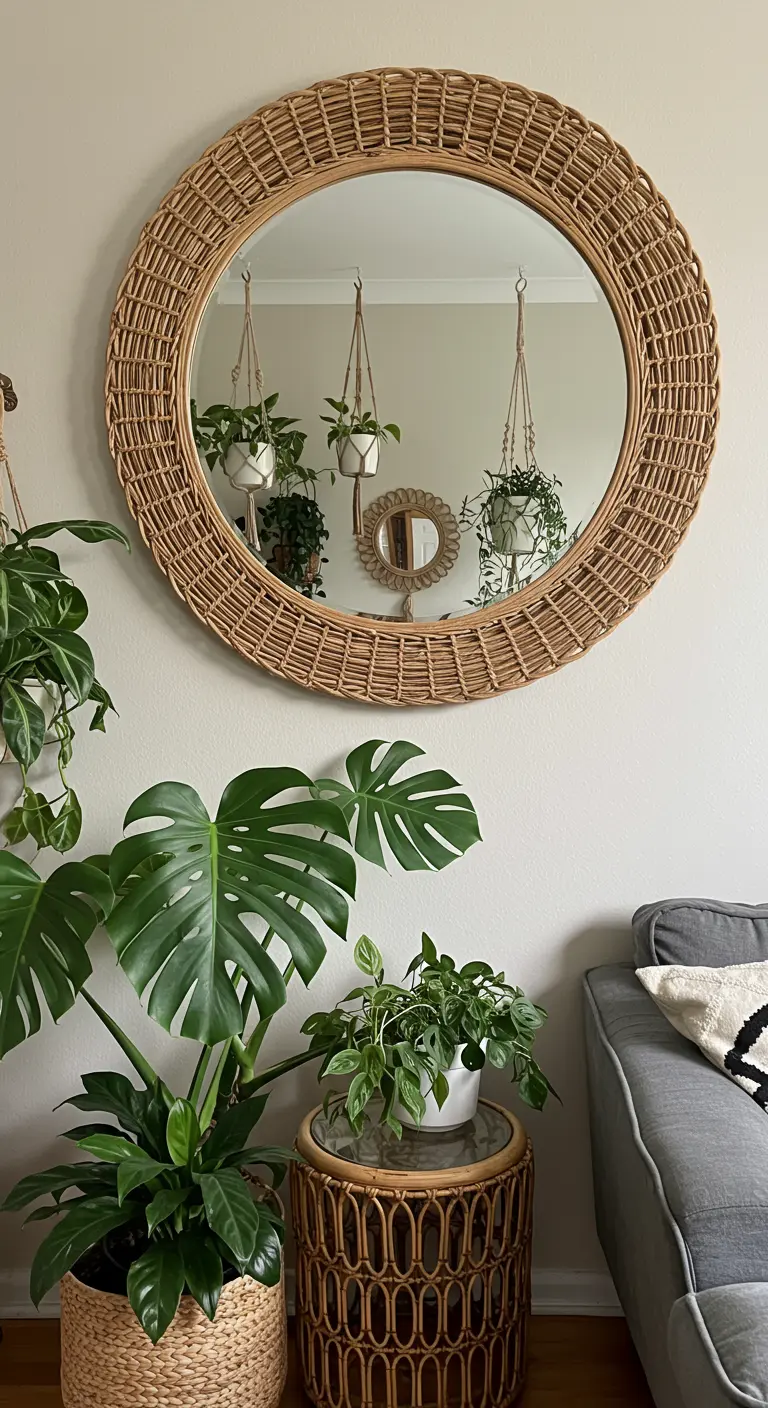
A mirror’s frame is just as important as its reflection for contributing to your room’s design.
A frame made of a natural, tactile material like rattan or wicker adds warmth and texture, preventing the space from feeling too cold or flat.
This strategy is perfect for nature-inspired small spaces, where it complements houseplants and other organic elements beautifully.
22. Choose an Easel Mirror for Flexibility
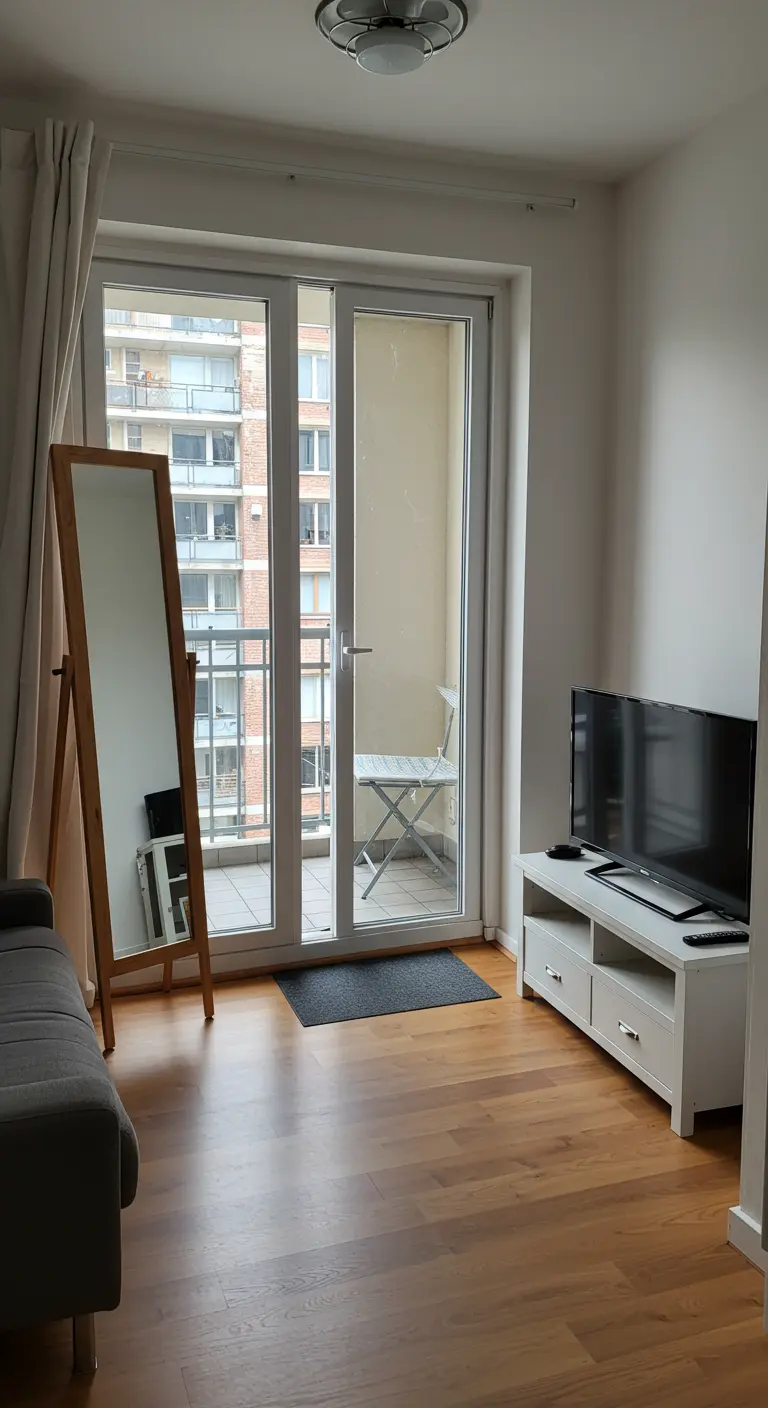
An easel-style floor mirror is not only a functional object but also a sculptural piece in its own right.
Its freestanding design gives you the flexibility to move it around the room, allowing you to capture the best light or to adapt to a new furniture arrangement.
It adds an artistic, studio-like quality that feels both casual and considered.
23. Layer Mirrors in a Maximalist Room
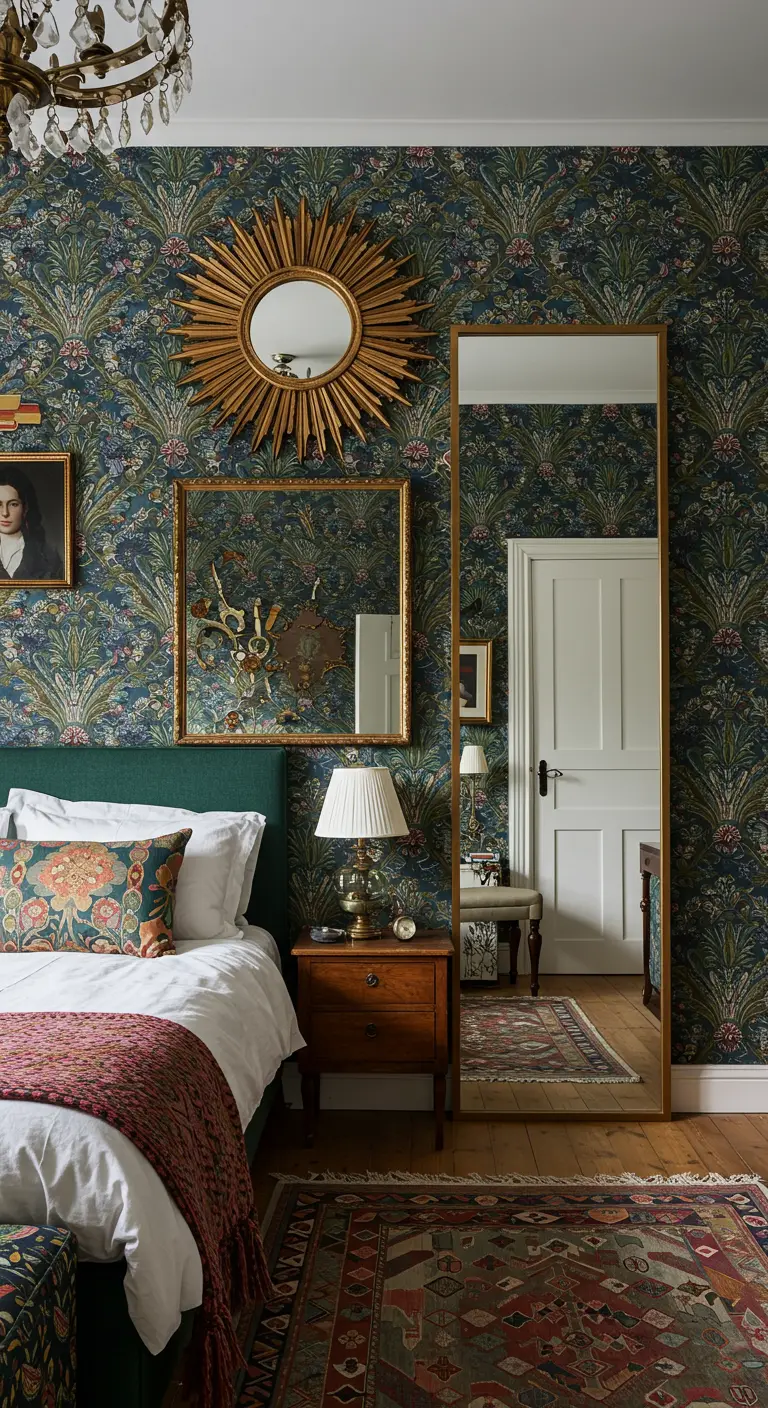
In a space defined by bold wallpaper and rich patterns, mirrors provide essential breathing room.
Don’t be afraid to layer multiple mirrors—a large floor mirror, an ornate wall mirror, and a sculptural sunburst—to amplify the effect.
They will break up the pattern and reflect light, color, and texture in dynamic ways, enhancing the room’s delicious complexity and depth.
24. Fake a Window with a Gridded Mirror
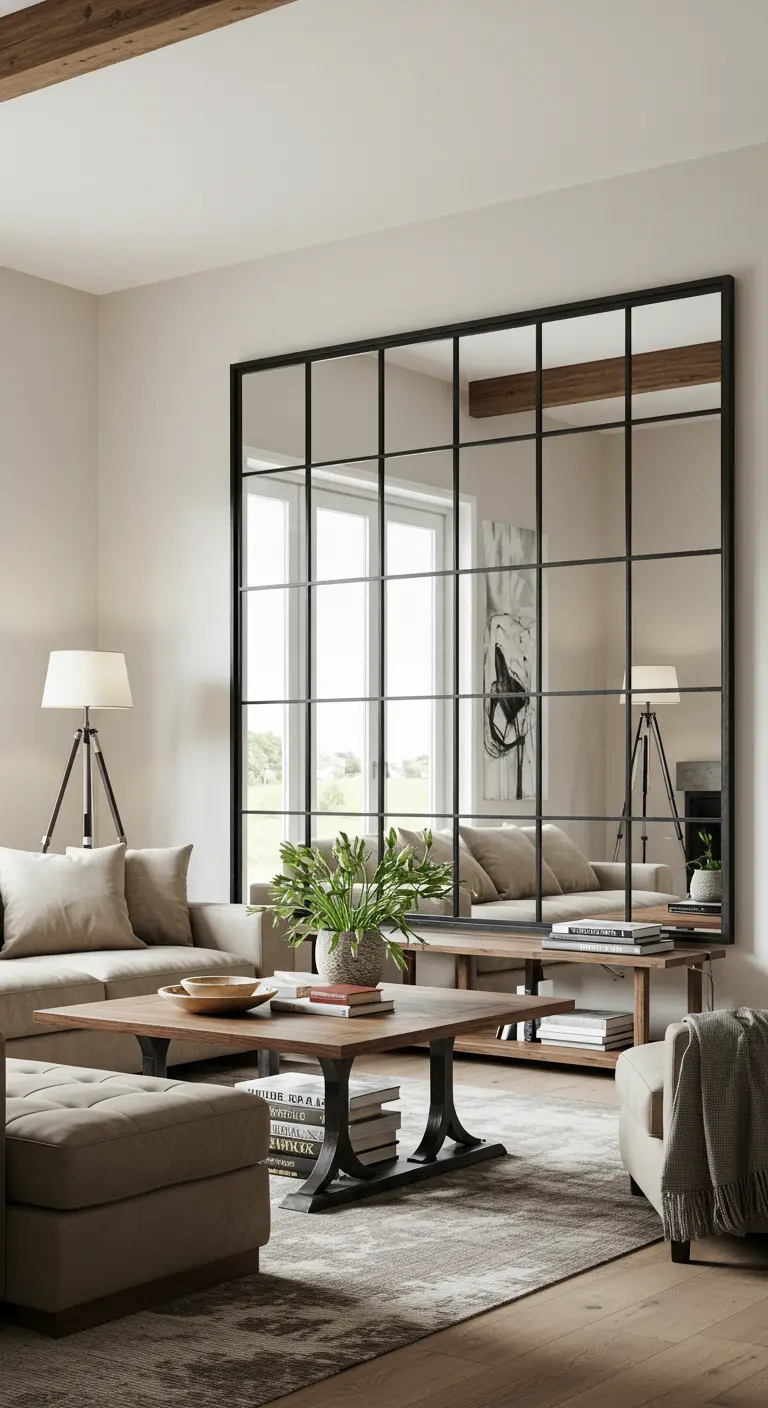
A large, windowpane-style mirror is one of the most beloved tricks in interior design for good reason.
Placed on a significant blank wall, it convincingly creates the illusion of an additional window, adding light and a sense of architecture.
The grid structure, usually in black metal, grounds the piece and gives it an industrial or farmhouse feel, making it a perfect fit in modern farmhouse aesthetics.
25. Draw the Eye Up with a Mirrored Ceiling
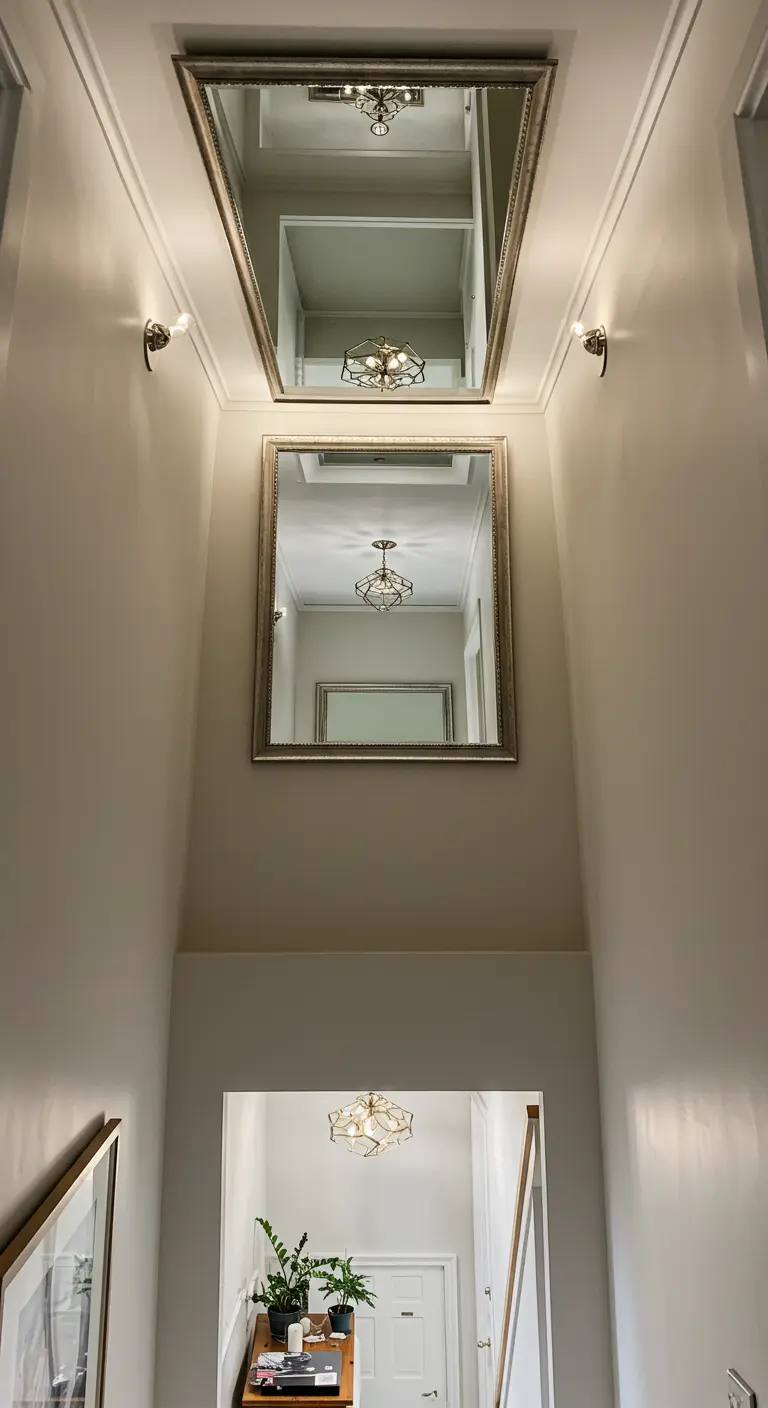
For a truly bold and glamorous statement, consider the fifth wall: the ceiling.
Installing mirrored panels on the ceiling, particularly in a space with some height like a hallway or stairwell, creates a dazzling, seemingly infinite reflection.
This unexpected application draws the eye vertically and adds a sense of limitless height and unforgettable drama.
26. Expand a Dining Nook with Mirror Panels

A built-in banquette is a fantastic space-saver, but it can feel enclosed.
Line the walls behind the seating with large, custom-fit mirror panels to visually push them back.
This simple addition makes the entire dining nook feel more spacious and sociable, and it has the wonderful effect of doubling the glow of candles or pendant lights during a meal.
This is a core strategy for successful small dining corners.
27. Use a Sculptural Mirror as Artwork
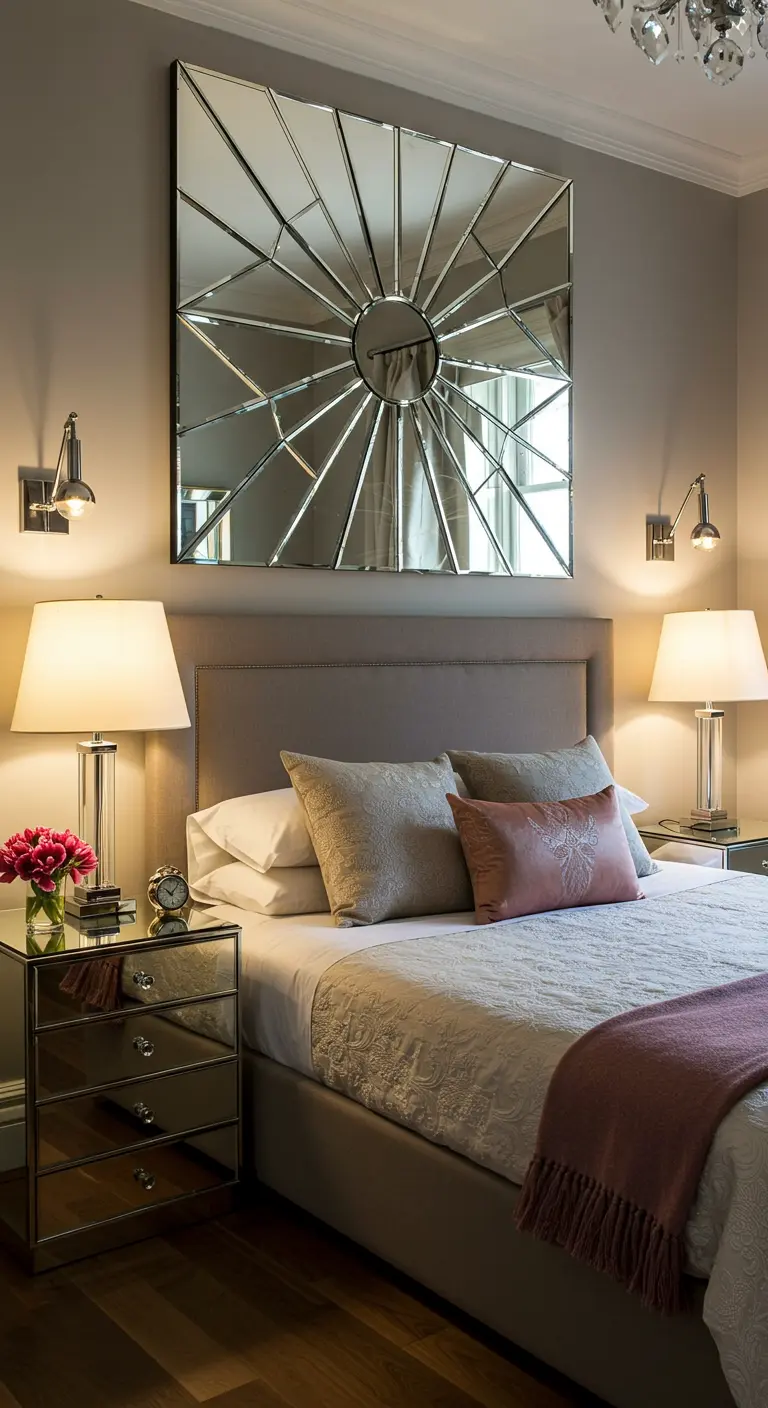
Let your mirror serve as the primary piece of art in a room.
Choose a design with a strong decorative presence, such as a faceted sunburst or a geometric Art Deco piece, and hang it above a bed or sofa.
It commands attention, provides a stunning focal point, and serves the dual purpose of reflecting light in beautiful, fractured patterns.
This approach is central to many Art Deco glam bedroom designs.
28. Soften Corners with a Leaning Arch Mirror
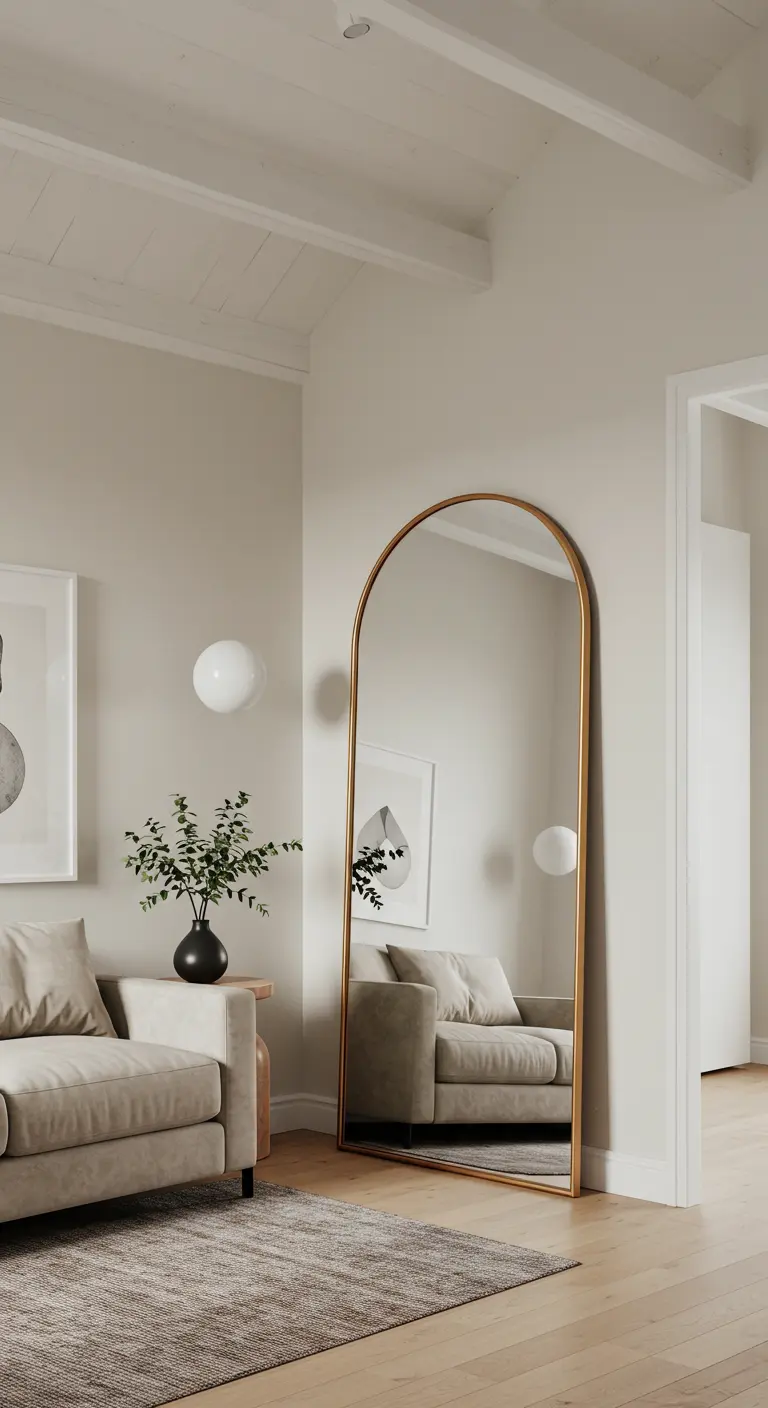
The elegant curve of an arched mirror is perfect for softening the sharp, right angles of a room.
A tall, full-length version leaned casually in a corner draws the eye to an often-neglected spot, creating a graceful vignette.
The reflection adds depth, while the shape itself adds a touch of architectural softness and on-trend sophistication.
29. Mount a Mirror on the Back of a Door

When wall and floor space is nonexistent, look to your doors.
Mounting a full-length mirror directly onto the back of a bedroom or closet door is the ultimate space-saving maneuver.
It provides the functionality you need without taking up a single inch of visual real estate, keeping your small room feeling as open as possible.
30. Create Moody Depth with Smoked Mirrors

If you find standard mirrors too bright or jarring, consider a wall of smoked or bronze-tinted panels.
The darker, muted reflection adds a profound sense of depth without the intense brightness, creating a chic, sophisticated, and moody atmosphere.
This technique is exceptionally effective in moody small spaces, where it enhances a dramatic design scheme while still expanding the room.
31. Install Mirrors Above a Doorway

Borrow an idea from classic architecture by installing a horizontal mirror—or a series of them—above a doorway.
This creates the look of a transom window, an elegant detail that tricks the eye into thinking the ceilings are higher than they are.
It also gives the impression that light is being shared between rooms, enhancing the bright, airy feeling of your home.
